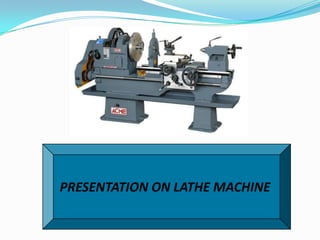Lathe machine
- 1. PRESENTATION ON LATHE MACHINE
- 2. PRINCIPLE OF LATHE ï Lathe is a machine, which is used to remove metal from the workpiece to required shape and size.
- 4. TYPES OF LATHES âĒSpeed Lathe : It is the simplest type lathe. It is mainly used for metal spinning, polishing etc. âĒBench Lathe : It is small sized engine lathe mounted on bench. It is used for turning small and light weight workpiece. âĒTool Room Lathe : It is used for production of small tools, gauges, fixtures and accurate parts in tool room.
- 5. âĒTurret Lathe : These lathes are used in mass production and for heavy duty workpieces. âĒCapsten Lathe : These lathes are used in mass production used for light duty workpieces. âĒSpecial Purpose Lathe : These lathes are modification of engine lathes developed for machining special types of workpices.
- 6. âĒAutomatic Lathe âĒEngine Lathe âĒTracer Lathe âĒComputer Controlled lathe âĒSwiss Type Automatic Lathe âĒDuplicating Lathe
- 7. COMPUTER NUMERICALLY CONTROLLED LATHE ï Computer Numerical Controls (CNC) ï Equipped with one or more turrets ï Each turret is equipped with a variety of tools ï Performs several operations on different surfaces of the workpiece
- 8. TURRET LATHE Capable of performing multiple cutting operations on the same workpiece ï Turning ï Boring ï Drilling ï Thread cutting ï Facing Turret lathes are very versatile Types of turret lathes ï Ram-type: ram slides in a separate base on the saddle ï Saddle type: ï more heavily constructed ï Used to machine large workpeiceces
- 9. ENGINE LATHE
- 10. BENCH LATHE AUTOMATIC LATHE
- 11. PARTS OF LATHE âĒBed : Supports all major components âĒCarriage: šÝšÝßĢs along the ways and consists of the cross-slide, tool post, apron âĒHeadstock : Holds the jaws for the work piece, supplies power to the jaws and has various drive speeds âĒTailstock : Supports the other end of the workpiece âĒFeed Rod and Lead Screw : Feed rod is powered by a set of gears from the headstock
- 12. LATHE BED âĒHeavy, rugged casting âĒMade to support working parts of lathe âĒOn top section are machined ways âĒGuide and align major parts of lathe
- 13. HEADSTOCK ï Clamped on left-hand end of bed ï Headstock spindle ï Hollow cylindrical shaft supported by bearings ï Provides drive through gears to work-holding devices
- 14. CARRIAGE ï Used to move cutting tool along lathe bed ï Consists of three main parts ï Saddle ï Cross-slide ï Apron
- 15. APRON
- 16. 16 TAILSTOCK
- 17. ACCESSORIES ï Chucks : ï Three jaw chuck ï Four jaw chuck ï Collet chuck ï Centres: ï Live centre ï Dead centre ï Tipped centre ï Ball centre ï Mandrels : ï Plain mandrel ï Stepped mandrel ï Collared mandrel ï Screwed mandrel
- 18. ï Chucks : âĒ Three Jaw Chuck (Self Centering Chuck) : This chuck is used to hold circular workpiece and is available in sizes from 100mm to 600 mm. ï Four Jaw Chuck (Independent Chuck) : It is used to hold rectangular, sqare and irregular shaped workpieces . ACCESSORIES
- 19. ï Collet Chuck : ï Pull poerating rod ï Push poerating rod It is ideal for holding tube and thin walled workpieces.
- 20. ï Centres: ï Live Centre ï Dead Centre ï Ball Centre ï Pipe Centre ï Half Centre ï Tipped Centre
- 21. ï Mandrels : ï Plain Mandrel ï Collared Mandrel ï Screwed Mnadrel ï Stepped Mandrel
- 22. LATHE OPERATIONS
- 24. BORING ï Boring produces circular internal profiles in hollow workpieces ï Boring mills are used for large workpieces ï Holes can be bored up to 20M if needed ï See fig. 22.20 ï Machines are available with a variety of features ï Horizontal boring machines ï Jig borers
- 25. TURNING ï Forces in turning ï Cutting force: acts downward on the tool tip ï Thrust force: acts in the longitudinal direction ï Radial force: acts in the radial direction ï Roughing and Finishing Cuts ï Rough cut: high speed cut with little regard for dimensional tolerance ï Finishing cut: lower feed rate and depth of cut ï Tool Materials, Feeds, and Cutting Speeds ï Cutting Fluids
- 26. CONCEPT OF SPEED, FEED AND DEPTH OF CUT âĒCutting speed=Î dn mm/min 1000 âĒFeed : âĒIt is expressed in mm/rev âĒDepth of cut : t=D-d mm 2
- 27. SINGLE POINT CUTTING TOOL GEOMETRY âĒClearance âĒRake âĒEnd cutting edge angle âĒSide cutting edge angle


























